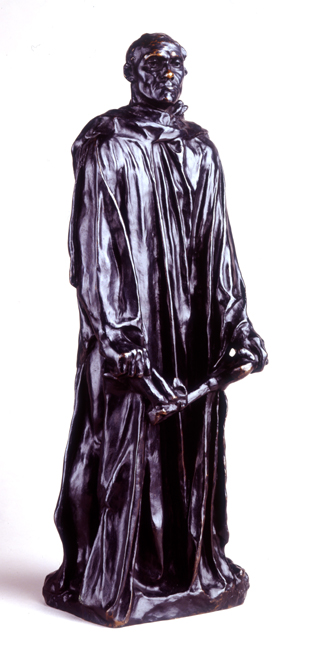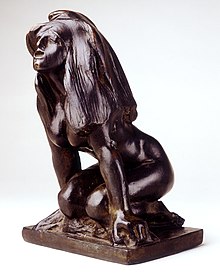
François Auguste René Rodin was a French sculptor, generally considered the founder of modern sculpture. He was schooled traditionally and took a craftsman-like approach to his work. Rodin possessed a unique ability to model a complex, turbulent, and deeply pocketed surface in clay. He is known for such sculptures as The Thinker, Monument to Balzac, The Kiss, The Burghers of Calais, and The Gates of Hell.

The Gates of Hell is a monumental bronze sculptural group work by French artist Auguste Rodin that depicts a scene from the Inferno, the first section of Dante Alighieri's Divine Comedy. It stands at 6 metres high, 4 metres wide and 1 metre deep (19.7×13.1×3.3 ft) and contains 180 figures.
A succubus is a type of female demon said to initiate sexual intercourse on males.

The Alsatian Orphan / L'Orpheline Alsacienne is a sculpture made by the French artist Auguste Rodin (1840-1917). In the beginning of his career, Rodin made decorative pieces. This piece was created during this phase.

The Falling Man is a sculpture by French artist Auguste Rodin modeled in 1882 and is part of Rodin's emblematic group The Gates of Hell.

I Am Beautiful, also known as The Abduction, is a sculpture of 1882 by the French artist Auguste Rodin, inspired in a fragment from Charles Baudelaire's collection of poems Les Fleurs du mal.

Fugitive Love is a sculpture by Auguste Rodin made between 1886 and 1887, both sculpted in marble and cast in bronze. It represents a man and a woman embracing each other on top of a rock. More specifically, the author was inspired by the story of Francesca da Rimini's love affair with Paolo Malatesta, an allusion to Dante Alighieri's depiction of lust on the second circle of Hell in his Inferno.

Pierre de Wissant is a bronze sculpture by French artist Auguste Rodin, part of his sculptural group The Burghers of Calais. This sculpture represents one of the six burghers who, according to Jean Froissart surrendered themselves in 1347, at the beginning of the Hundred Years' War (1337–1453), in order to save the inhabitants of the French city of Calais from the English laying siege to the city.

Head of Camille Claudel is a polychrome glass paste sculpture by the French artist Auguste Rodin, conceived in 1884 and executed in 1911. It is now in the Museo Soumaya in Mexico City. It shows his then studio assistant Camille Claudel in a Phrygian cap.

Danaid is a sculpture by Auguste Rodin, based on the account in the Metamorphoses of Hypermnestra, eldest of the Danaïdes.

The Old Tree is a plaster sculpture by the French artist Auguste Rodin, originally conceived as part of his The Gates of Hell project.

Adonis Awakens is an 1889 sculpture by the French artist Auguste Rodin. Based on the account of Adonis in Book 10 of Ovid's Metamorphoses, it is signed “A RODIN” on the edge of the base. It is now in the Museo Soumaya in Mexico City.

The Kneeling Man is a work originally conceived in 1888 by the French artist Auguste Rodin for his The Gates of Hell project.

Glaucus is a sculpture by the French artist Auguste Rodin, first conceived in 1886 as a representation of the mythological figure Glaucus, son of Poseidon. Originally made in plaster, bronze casts of it are now in the Brooklyn Museum and the Museo Soumaya.

Jean d'Aire is a sculpture by the French artist Auguste Rodin, first conceived around 1885 as part of the planning for his group The Burghers of Calais.

Youth Triumphant is one of the sculptures created by Auguste Rodin as part of the planning for his The Gates of Hell. It was inspired by Jean Dampt's The Grandmother's Kiss, exhibited in 1893. That work shows a young woman resting in the arms of an old woman, with the pair deeply kissing.

The Shade, The Slave or The Titan is a sculpture by the French artist Auguste Rodin.

Meditation or The Interior Voice is an 1886 sculpture by Auguste Rodin, showing a young woman resting her head on her right shoulder.

Damned Women is a sculpture created by Auguste Rodin between 1885 and 1890 as part of his The Gates of Hell project—it appears on the upper right as the counterpart to The Fallen Caryatid.



















